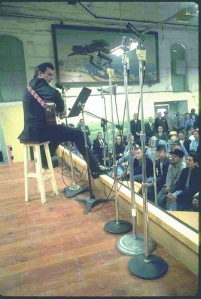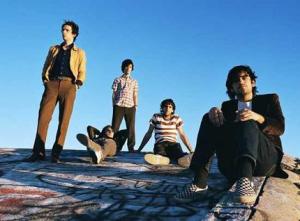I’ve been on a Johnny Cash kick lately and keep going back to his 1968 and 1969 prison classics – At Folsom Prison and At San Quentin. A lot has been written about these records and their importance so for a change of pace, I wanted to just listen to them back to back and document my impressions.
The first thing I noticed is that Folsom sounds so much more polite. The audience, the band, the setlist, Johnny himself. Although it’s in a prison, it sounds mostly like a standard concert performance. You need the stage announcements and Johnny’s banter to let you know where you are. For the most part though, everyone seems to behave themselves.
As far as the setlist goes, Folsom is more prepared. You’ve got your badass songs, (title track, “Busted,” “Cocaine Blues”) your death songs (“The Long Black Veil,” “Send a Picture to Mother”), your comedy section (“Dirty Old Egg Suckin’ Dog,” Flushed Down the Toilet of Your Heart”), and your quiet love songs, nearly in that order. Like Johnny planned it that way specifically for that crowd. This isn’t a bad thing. A lot of the power of the recording comes from the thoughtfulness Cash put into the set.
Johnny is funny and charming and has the crowd listening to songs like the rollicking, “Cocaine Blues” as intently as they do the beautiful, “Give My Love to Rose.” The way he paints the picture that he’s one of them by tailoring the set to them, joking on their behalf about the water tasting like it “ran off Luther’s boot” is pretty brilliant. And the band follows. Two-stepping song after song after song, following Johnny when he extends a verse too long or waits for mid-song applause to end. They’re always there.
The recording is fantastic and if you listen through the very end of the CD reissue, you hear about 90 seconds of stage announcements and the prisoners filing out of the room.
For being so similar conceptually, San Quentin is a different animal. First off, the band is different. Johnny’s longtime guitarist, Luther Perkins, died between the recording of At Folsom Prison and San Quentin and was replaced by Bob Wootton (and Carl Perkins on some tunes), who’s guitar is even dirtier and treblier than Perkins’ had been. The impact is pretty large as the band sounds more punk rock than it had on Folsom.
The crowd sounds different as well – bigger and more raucous than at Folsom, like someone had snuck in some beer. Possibly because of this, Johnny is different – loose, unhinged. He even alludes to his “dope” in a bag in the back room. It could’ve been a wink at the fact that he was playing a prison but hearing about his indulgences at the time, I doubt it.
The set tends to ramble around but for my money, is stronger than Folsom with classics like “Big River,” “A Boy Named Sue,” “Wanted Man,” getting their place alongside a faster, dirtier “Folsom Prison Blues” (Any of these songs would make nice additions to our Great Songs category, by the way.) Johnny sings them with the power and anger that they deserve, giving the set more balls.
In the end, both are great documents of Johnny Cash’s career and testaments to his power and talent. But if At Folsom Prison is the train coming straight down the track to San Antone, San Quentin is the boxcar, out of control, headed God knows where.
Ultimately, both will get you where you’re going.










